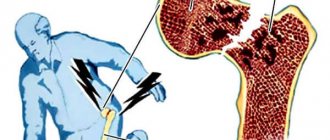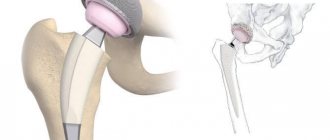The hip joint is the largest in the human body, therefore, when its functions are impaired, a severe decrease in performance is observed. Often, to prevent complications and maintain mobility of the joint, endoprosthetics is performed - replacing it with a prosthesis. The goal of such an operation is to stop the pathological process and restore the patient’s ability to work. Therefore, disability after hip replacement is not always given. Most often, patients agree to surgery in the hope of avoiding disability. But it happens that this cannot be done and the person becomes disabled.
Progress of hip replacement
The hip joint is very complex and can withstand heavy loads. Therefore, replacing it with a prosthesis is practiced only in extreme cases. Indications for endoprosthetics may include:
- severe deforming osteoarthritis;
- complications after injuries or other joint pathologies;
- consequences of rheumatoid arthritis;
- necrotic processes due to impaired blood supply;
- tumors.
The goal of endoprosthetics is to restore mobility to the joint and the patient’s ability to work. Such operations are performed in two ways.
Partial arthroplasty involves replacing only the femoral head. Such a prosthesis is temporarily effective, since the process of destruction of the joint can continue.
Complete or total arthroplasty involves completely removing parts of the joint and replacing them with a prosthesis. Such designs restore mobility to the joint. Modern endoprostheses are reliable and retain functionality for 10-20 years.
Some people believe that disability is mandatory after a hip replacement. But that's not true. After all, the purpose of the operation is to restore mobility. Many patients agree to it precisely in order to avoid disability. And most often this is what happens.
Correctly performed surgery and compliance with all doctor’s recommendations during rehabilitation can avoid disability after hip replacement. But such an outcome is also not excluded. Some patients develop complications that negate all the positive results of the operation.
The outcome of endoprosthetics depends on the patient’s age, health status, the presence of chronic diseases and the severity of joint pathology.
Complications after surgery
Endoprosthetics is a difficult operation, so complications can develop for various reasons. Especially often this is the presence of chronic diseases or physiological characteristics of old age, which do not allow the prosthesis to take root. But medical errors cannot be ruled out.
Sometimes complications result from the use of low-quality prostheses, as well as non-compliance with doctor’s recommendations during rehabilitation. The most common negative consequences are:
- infectious process;
- prosthesis rejection;
- thrombosis;
- degenerative processes in surrounding tissues;
- dislocation of the joint.
If the integrity of the prosthesis is compromised or purulent complications occur, another operation is often performed, and sometimes a replacement of the prosthesis is required. Disability with repeated hip replacement is more common, since it is more difficult to restore performance.
Complications after surgery
Due to various factors (the patient’s age, his general health, the severity of the injury, the presence of concomitant pathologies), even with the most favorable outcome of the operation, the risk of complications cannot be excluded. Among them:
- introduction of infection;
- thrombosis;
- prosthesis rejection;
- dislocation of an established joint;
- complicating the course of chronic diseases.
The main reasons for the development of postoperative complications:
- low quality of the prosthesis used or its incorrect selection;
- incorrect installation of the device, negligence of the surgeon during prosthetics;
- lack of proper and complete rehabilitation.
In some situations, repeat endoprosthesis replacement is required. The main indications for its implementation are:
- instability (looseness) of the artificial joint;
- connection of purulent infection;
- violation of the integrity of the device;
- the appearance of a pathological structure in the area of the articular cup.
Secondary surgery requires the use of a unique technique for each individual case.
Work ability examination
The question of whether disability is given after replacement with a hip joint prosthesis cannot be resolved unambiguously. Each case must be approached individually. Most often, after surgery, patients return to full activity after some time. But sometimes motor activity disorders develop, which lead to a limitation of the patient’s ability to work.
In order to determine the extent of these disorders and conclude whether the patient is considered disabled, it is necessary to undergo an examination.
Passing a medical and social examination
If you are wondering whether replacement with a hip joint prosthesis gives you disability, you should contact your doctor. If a person experiences severe pain, joint mobility is reduced, and he cannot work normally, he is referred to a medical and social commission. Only a special examination can determine whether a patient is entitled to disability.
Undergoing X-ray diagnostics
To determine whether the patient has a limitation in motor activity, as well as whether there are pathological changes in the tissues, an X-ray diagnosis is required. It is made using the Kosinskaya method.
3 degrees of violations are determined. In the image you can see a narrowing of the joint space, bone deformation, the presence of osteophytes, a violation of the integrity of the prosthesis, and the presence of pieces of cartilage in the cavity.
Carrying out functional diagnostics
This examination method allows you to determine the functionality of the joint. Based on special tests, the degree of limitation of his mobility is revealed:
- at the first degree it is 20-300;
- with the second – up to 500;
- Grade 3 is characterized by ankylosis or preservation of mobility of no more than 150;
- at grade 4, joint deformation and complete fixation are observed.
Determination of the degree of statodynamic function
Based on an X-ray examination and a doctor’s examination, the degree of motor impairment is determined. They can be:
- small, when pain occurs only after physical activity and subsides with rest;
- with a moderate degree, the patient constantly limps;
- severe disorders are accompanied by constant pain, shortening of the limb;
- in severe cases, joint immobility is observed.
Disability after joint replacement - is it allowed or not?
Deforming osteoarthritis (DOA), which develops due to injury, congenital dysplastic or inflammatory disease, can lead to a serious deterioration in all life activities.
This manifests itself in constant, oppressive pain, the inability to move normally and do the same work. Often deforming arthrosis is the cause of disability. One of the treatment methods for DOA is endoprosthetics.
Many people believe that knee or hip replacement automatically gives you disability . Is it so?
Disability with DOA and after endoprosthetics
There are a lot of indignant letters on medical forums on the Internet, with approximately the following content:
My mother, a nurse at City Hospital No. 2, had knee replacement surgery a year ago. Since then, she has been tormented by constant pain, especially her leg aching before the weather changes. She can't bend her knee like she used to, and she can't run. We submitted documents to the ITU, but after the operation they didn’t give her any group... Why?..
To understand this, let’s look at the principle by which disability is generally given for diseases of the musculoskeletal system.
The basis for assigning a disability group may be:
- Deforming arthrosis of both hip or knee joints is not lower than the second stage of arthrosis and moderate degree of joint dysfunction
- DOA of one or more joints (hip, knee, ankle, shoulder, elbow, wrist) in stage III, with ankylosis or shortening of the limb
- Bilateral endoprosthetics, leading to severe disorders
Thus, endoprosthetics surgery itself is not a reason for disability. On the contrary, surgery can be recommended in the late stage of DOA as a method of treating arthrosis and the possibility of removing a number of limitations in life activity (LLD)
A person agrees to an operation, not wanting to become disabled, but on the contrary, wanting to avoid disability.
Another thing is when the joint replacement was unsuccessful for some reason:
- The quality of the prosthesis is low
- The surgeon did not perform computer navigation and unsuccessfully selected the geometric dimensions of the prosthesis
- After the operation, the patient did not undergo rehabilitation or did not undergo it as it should have been
Referral to MSE after endoprosthetics is given in the event of moderate and severe musculoskeletal disorders that lead to limitation of the patient’s life activity (LW)
Let's consider how the degree of musculoskeletal functions is determined and by what criteria the respiratory function is assessed in MSE.
Medical and social examination for deforming arthrosis
Post-traumatic arthrosis is considered the most unfavorable in its course, since it differs:
- The most pronounced dysfunctions (contractures, limitation of movements, shortening of the legs, muscle atrophy)
- Increased frequency of exacerbations
- The rate of disease progression
To conduct MSE, the following criteria for assessing the patient’s condition are required:
- X-ray diagnostics according to Kosinskaya
- Functional diagnostics
- Determination of the degree of statodynamic function (SDF)
- Determination of the degree of moderation of development of DOA:
- How quickly does the disease progress?
- How often do exacerbations occur?
- What complications does the disease cause?
X-ray diagnostics for MSE
Diagnostics during medical and social examination differs from the usual diagnostics used in modern medical practice:
- Thus, the degrees of arthrosis in medical orthopedics based on X-rays are today determined according to the Leuquesne classification - it distinguishes four degrees of arthrosis
- With MSE, the degrees of arthrosis are determined only according to the Kosinskaya classification (three degrees)
- The third degree according to Leuquesne may correspond to the second according to Kosinskaya, which is why controversial situations may arise.
- DOA degrees according to Kosinskaya
- First degree DOA:
- Slight limitation of movement
- Weak and uneven narrowing of the interarticular gap
- Initial osteophytes
Second degree DOA
- Restriction of joint movement in certain directions
- The appearance of a rough crunch when moving
- Narrowing of the gap by two to three times compared to the norm
- Moderate muscle atrophy
- The appearance of large osteophytes
- Signs of osteosclerosis and cystic cavities in the epiphysis of the subchondral bone
Third degree DOA
- Large joint deformations and hardening of bone surfaces
- Sharp limitation of mobility with preservation of rocking movements ranging from 5 to 7˚
- Large osteophytes over the entire surface of the joint
- Closing the joint gap
- Fragments of cartilage in the synovial cavity of the joint (articular mice)
- Subchondral brushes
With complete fusion, it is not DOA that is diagnosed, but ankylosis, which is informally considered the fourth stage of arthrosis
In what cases is disability granted?
Patients often wonder whether they are disabled after hip replacement surgery. They believe that if they were given a prosthesis, this automatically means that they have become disabled. Therefore, they are very surprised if the doctor refuses them this.
If the joint is replaced with a prosthesis, this is not a reason to prescribe a group. On the contrary, surgery is most often performed to relieve disability in a patient with DOA or rheumatoid arthritis.
Basis for obtaining a disability group
But sometimes surgery does not restore joint function. The reason for this may be:
- low quality of the prosthesis;
- incorrectly selected size;
- medical error;
- failure to comply with the doctor’s requirements for rehabilitation.
Each case is considered separately. The basis for assigning a group is only a violation of motor functions, which leads to the inability to perform work duties.
Third disability group
Most often, after such an operation, disability group 3 is given. It is usually prescribed if the patient develops minor complications or has difficulty regaining mobility. The group is given for 1 year, after which it is necessary to undergo re-examination.
Second and first group
For more serious mobility impairments, group 2 is given. Most often, the basis for its appointment is a bilateral operation, the development of ankylosis or other pathologies leading to severe disability.
The question of whether group 1 disability is given when replacing a hip joint with a prosthesis is most often answered negatively. This happens if the operation was unsuccessful, there was bilateral endoprosthetics, and it did not lead to an improvement in the functions of the joint. Group 1 is given to a patient who cannot move independently at all.
Complications leading to disability
In the first year after prosthetics, complications may develop that make a person disabled:
- Dislocations and subluxations that disable the endoprosthesis. More often they occur during heavy physical exertion or due to improper selection of the implant.
- Infection of the prosthesis. Infection in the tissue area near the artificial joint comes from foci of chronic inflammation in the body (sore teeth, genitourinary diseases, inflammatory processes in bones or cartilage).
- Vein thrombosis of the limb. Blood clots occur if the patient refuses to undergo rehabilitation or leads a sedentary lifestyle.
- Periprosthetic fracture. At the site where the wedge-shaped leg of the prosthesis is installed, bone strength decreases and a fracture can occur even several years after endoprosthetics.
- Neuropathy. It develops when the nerve roots are affected during surgery. Impaired innervation leads to decreased mobility and muscle atrophy.
- Implant rejection. When using low-quality materials, the prosthesis “does not take root.” Pain, swelling and hyperemia persist in the joint area.
If the listed complications occur, the patient is assigned a temporary disability group and the necessary treatment is prescribed.
Registration procedure
In order to register a disability, you must undergo a full examination. In addition to functional diagnostics and testing, it includes consultation with some specialized specialists.
After this, the patient is given a conclusion about his condition and a referral for medical examination.
Based on these documents, the medical and social commission assesses the degree of mobility impairment of the patient and his ability to perform professional duties. A decision is made to assign him a disability group or a refusal is given.
Preparation for joint replacement
The first step is a comprehensive examination of the patient, taking laboratory tests, taking an ECG, conducting an X-ray examination of the joint or taking a tomogram. These measures are necessary both to clarify the diagnosis and to determine the tactics of the operation, as well as to select the optimal design of the endoprosthesis (today there are more than 70 of them). In some cases, the opinions of related specialists are necessary.
If the patient is taking anticoagulants (aspirin and its derivatives), it is necessary to notify the doctor, who will most likely order such medications to be stopped several days before surgery. Drugs of this kind slow down blood clotting, which can cause complications both during the operation and in the recovery period.
You should not eat or smoke for six hours immediately before surgery.
Work ability
After the operation, temporary loss of ability to work is observed. If it is accompanied by complications, the patient can be temporarily assigned to group 3 for 1 year. During this time, he must undergo rehabilitation and all medical measures prescribed by the doctor.
But ITU may refuse to assign disability to those whose work activities do not involve stress on their legs. A person can maintain his ability to work if he works in an office as a dispatcher.
Hip replacement is a very complex operation. If complications occur, there may be a violation of motor functions, due to which the patient cannot perform his work duties. In this case, he is entitled to disability.
What is the hip joint
The connection between the pelvic bone and the femur is called the hip joint (HJ). The structure of the joint provides support and mobility during movement. The anatomical structure includes:
- spherical head of the tibia, covered with smooth articular tissue;
- acetabulum (formed by the fusion of 3 pelvic bones), lined with smooth hyaline cartilage;
- joint capsule (a capsule of connective tissue covering the cavity and head of the bone), filled with synovial fluid.
Smooth articular cartilage ensures smooth gliding of bone surfaces during movement, and synovial fluid helps reduce friction between the head of the tibia and the acetabulum.
The hip joint is surrounded by powerful ligaments that provide support during movement and prevent the occurrence of anatomical disorders (dislocations).
The muscle groups located around the hip joint allow movement in different planes:
- internal and external rotation of the hip;
- abduction of the lower limb forward, sideways and backward;
- rotation in the joint;
- body bends.
The structure of the hip joint allows it to withstand heavy loads and ensure mobility of the joint when walking. Organic damage to one or more joint elements is accompanied by functional disorders.
For what diagnoses is surgery strictly necessary?
For a hip fracture, surgery is necessary the sooner the better, since this problem occurs in older people. If the operation is delayed, such patients are difficult to rehabilitate. With arthrosis, everything depends on how the patient assesses his condition, pain syndrome, and whether he is mentally ready to undergo surgery, regardless of what the doctor recommended. If you delay surgery for severe arthrosis, the remaining joints and spine suffer, and deformity appears. The sooner the patient undergoes surgery, the easier and faster the recovery.
When is endoprosthetics impossible?
Joint replacement is a serious intervention in the human body. You will have to refuse surgery if a person has the following diseases:
- Diabetes type 1 or 2.
- Poor blood clotting.
- Recent stroke or heart attack.
- Liver failure.
- Asthma and other bronchopulmonary diseases.
- Blood poisoning within 5 years before the proposed operation.
- Oncological diseases.











